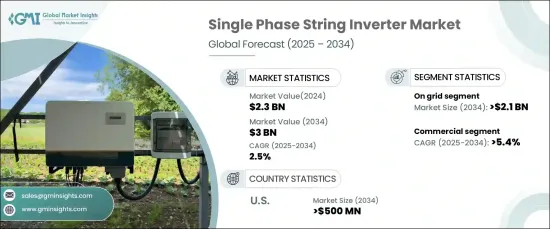 |
市场调查报告书
商品编码
1665368
单相串式逆变器市场机会、成长动力、产业趋势分析及 2025 - 2034 年预测Single Phase String Inverter Market Opportunity, Growth Drivers, Industry Trend Analysis, and Forecast 2025 - 2034 |
||||||
2024 年全球单相串式逆变器市场价值为 23 亿美元,预计 2025 年至 2034 年期间将以 2.5% 的复合年增长率稳步增长。它们的主要功能是将太阳能电池板产生的直流电(DC)转换为交流电(AC),使其与单相电网相容。

人们对永续性和能源独立的认识不断增强,这是推动太阳能应用的主要驱动力,从而推动了对单相串式逆变器的需求。随着人们对气候变迁的担忧加剧,向再生能源的转变势头强劲,尤其是在住宅领域。这种转变,加上太阳能技术的快速进步,正在推动市场成长并鼓励这些高效能能源系统的广泛使用。
| 市场范围 | |
|---|---|
| 起始年份 | 2024 |
| 预测年份 | 2025-2034 |
| 起始值 | 23亿美元 |
| 预测值 | 30亿美元 |
| 复合年增长率 | 2.5% |
按连接性进行市场细分錶明,市场主要关注併网系统,预计到 2034 年将产生 23 亿美元的市场规模。这些系统与公用电网无缝集成,使用户能够透过净计量计划将多余的能源卖回给电网,从而降低电力成本并提高可负担性。降低碳排放和减少对化石燃料的依赖的力度不断加大,推动了併网太阳能解决方案的采用。
市场进一步按应用分类,其中住宅和商业领域显示出强劲的成长潜力。特别是商业领域,预计到 2034 年将以令人印象深刻的 5.5% 的复合年增长率增长,这得益于其针对中小型企业的可扩展性和成本效率。单相串式逆变器提供出色的投资报酬率 (ROI),并可根据不断变化的业务需求灵活地扩大能源生产规模。此外,紧凑、高效的空间设计解决了商业空间的安装难题,增强了产品的吸引力和采用率。
在美国,单相串式逆变器市场预计到 2034 年将达到 5.5 亿美元。人们对电网不稳定、停电和极端天气事件的担忧日益加剧,促使企业优先考虑能源弹性和安全性。随着企业寻求可持续、经济高效的解决方案来降低营运费用并增强能源独立性,市场将实现持续成长。
目录
第 1 章:方法论与范围
- 研究设计
- 基础估算与计算
- 预测模型
- 初步研究与验证
- 主要来源
- 资料探勘来源
- 市场定义
第 2 章:执行摘要
第 3 章:产业洞察
- 产业生态系统
- 监管格局
- 产业衝击力
- 成长动力
- 产业陷阱与挑战
- 成长潜力分析
- 波特的分析
- 供应商的议价能力
- 买家的议价能力
- 新进入者的威胁
- 替代品的威胁
- PESTEL 分析
第四章:竞争格局
- 介绍
- 战略仪表板
- 创新与技术格局
第五章:市场规模及预测:依连结性,2021 – 2034 年
- 主要趋势
- 独立
- 在电网上
第 6 章:市场规模与预测:按应用,2021 – 2034 年
- 主要趋势
- 住宅
- 商业的
第 7 章:市场规模及预测:按地区,2021 – 2034 年
- 主要趋势
- 北美洲
- 我们
- 加拿大
- 欧洲
- 德国
- 义大利
- 荷兰
- 英国
- 法国
- 亚太地区
- 中国
- 澳洲
- 印度
- 日本
- 韩国
- 中东和非洲
- 以色列
- 沙乌地阿拉伯
- 阿联酋
- 南非
- 拉丁美洲
- 巴西
- 墨西哥
- 智利
第八章:公司简介
- APsystems
- Canadian Solar
- Enphase Energy
- Fronius International
- Huawei Technologies
- INVTSolar
- NingBo Deye Inverter Technology
- Solaredge Technologies
- SUNGROW
- UTL Solar
The Global Single Phase String Inverter Market, valued at USD 2.3 billion in 2024, is projected to grow at a steady CAGR of 2.5% between 2025 and 2034. These inverters are integral to small and medium-sized photovoltaic systems, predominantly serving residential and small commercial applications. Their primary function is converting direct current (DC) generated by solar panels into alternating current (AC), making it compatible with single-phase electrical grids.

The rising awareness of sustainability and energy independence is a key driver of solar power adoption, fueling the demand for single-phase string inverters. As concerns about climate change intensify, the transition toward renewable energy sources gains momentum, particularly in residential sectors. This shift, combined with rapid advancements in solar technology, is propelling market growth and encouraging the widespread use of these efficient energy systems.
| Market Scope | |
|---|---|
| Start Year | 2024 |
| Forecast Year | 2025-2034 |
| Start Value | $2.3 Billion |
| Forecast Value | $3 Billion |
| CAGR | 2.5% |
Market segmentation by connectivity reveals a significant focus on on-grid systems, which are projected to generate USD 2.3 billion by 2034. On-grid inverters offer substantial cost advantages over their off-grid counterparts, which require expensive battery storage. These systems seamlessly integrate with utility grids, enabling users to sell surplus energy back to the grid through net metering programs, reducing electricity costs and improving affordability. Increasing efforts to lower carbon emissions and reduce reliance on fossil fuels are driving the adoption of grid-connected solar solutions.
The market is further categorized by application, with residential and commercial sectors showing robust growth potential. The commercial segment, in particular, is expected to grow at an impressive CAGR of 5.5% through 2034, bolstered by its scalability and cost efficiency for small to medium-sized businesses. Single-phase string inverters provide an excellent return on investment (ROI) and offer the flexibility to scale energy production in line with evolving business needs. Additionally, compact, space-efficient designs that address installation challenges in commercial spaces are enhancing product appeal and adoption.
In the United States, the single-phase string inverter market is forecasted to reach USD 550 million by 2034. Federal tax credits, state-level rebates, and financial incentives are driving solar photovoltaic installations across the country. Rising concerns over grid instability, power outages, and extreme weather events are prompting businesses to prioritize energy resilience and security. As companies seek sustainable, cost-effective solutions to reduce operational expenses and enhance energy independence, the market is positioned for sustained growth.
Table of Contents
Chapter 1 Methodology & Scope
- 1.1 Research design
- 1.2 Base estimates & calculations
- 1.3 Forecast model
- 1.4 Primary research & validation
- 1.4.1 Primary sources
- 1.4.2 Data mining sources
- 1.5 Market definitions
Chapter 2 Executive Summary
- 2.1 Industry synopsis, 2021 – 2034
Chapter 3 Industry Insights
- 3.1 Industry ecosystem
- 3.2 Regulatory landscape
- 3.3 Industry impact forces
- 3.3.1 Growth drivers
- 3.3.2 Industry pitfalls & challenges
- 3.4 Growth potential analysis
- 3.5 Porter's analysis
- 3.5.1 Bargaining power of suppliers
- 3.5.2 Bargaining power of buyers
- 3.5.3 Threat of new entrants
- 3.5.4 Threat of substitutes
- 3.6 PESTEL analysis
Chapter 4 Competitive landscape, 2024
- 4.1 Introduction
- 4.2 Strategic dashboard
- 4.3 Innovation & technology landscape
Chapter 5 Market Size and Forecast, By Connectivity, 2021 – 2034 (USD Billion & MW)
- 5.1 Key trends
- 5.2 Standalone
- 5.3 On grid
Chapter 6 Market Size and Forecast, By Application, 2021 – 2034 (USD Billion & MW)
- 6.1 Key trends
- 6.2 Residential
- 6.3 Commercial
Chapter 7 Market Size and Forecast, By Region, 2021 – 2034 (USD Billion & MW)
- 7.1 Key trends
- 7.2 North America
- 7.2.1 U.S.
- 7.2.2 Canada
- 7.3 Europe
- 7.3.1 Germany
- 7.3.2 Italy
- 7.3.3 Netherlands
- 7.3.4 UK
- 7.3.5 France
- 7.4 Asia Pacific
- 7.4.1 China
- 7.4.2 Australia
- 7.4.3 India
- 7.4.4 Japan
- 7.4.5 South Korea
- 7.5 Middle East & Africa
- 7.5.1 Israel
- 7.5.2 Saudi Arabia
- 7.5.3 UAE
- 7.5.4 South Africa
- 7.6 Latin America
- 7.6.1 Brazil
- 7.6.2 Mexico
- 7.6.3 Chile
Chapter 8 Company Profiles
- 8.1 APsystems
- 8.2 Canadian Solar
- 8.3 Enphase Energy
- 8.4 Fronius International
- 8.5 Huawei Technologies
- 8.6 INVTSolar
- 8.7 NingBo Deye Inverter Technology
- 8.8 Solaredge Technologies
- 8.9 SUNGROW
- 8.10 UTL Solar









